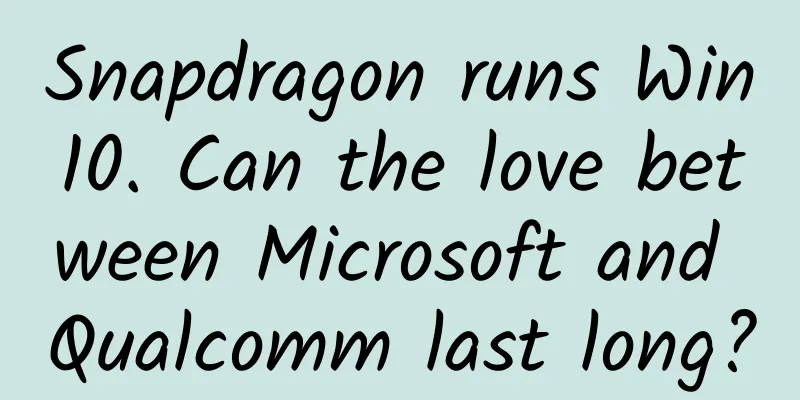Snapdragon runs Win10. Can the love between Microsoft and Qualcomm last long?

|
At the Microsoft WinHEC conference held in Shenzhen yesterday, in addition to the news of Hololens landing in China, the more exciting thing is the cooperation between Microsoft and Qualcomm on Windows 10. Simply put, it is under the ARM architecture, equipped with the Snapdragon 820 chip, and can run the complete Windows 10 operating system. As for what kind of productivity such a combination can achieve, the following short video can tell you. Microsoft Snapdragon 820 However, before Microsoft found its partner Qualcomm, it also took a lot of detours. We can start with Windows RT, ARM and X86, and Atom series processors... Confusion of Windows RT How do you evaluate this system? In fact, I would like to ask the current users of Windows RT devices about their feelings. Of course, he may say: "I smashed it a long time ago!" But it doesn't matter, let's talk about this system, because this is an independent version of Microsoft under the ARM architecture, and it also carried Microsoft's expectations for tablet products on the mobile device side. Windows RT Windows RT has nothing to do with the previous big brothers. It uses a new Metro style interface, and various applications, shortcuts, etc. can be presented on the screen in the style of dynamic blocks. In this system, Microsoft provides touch-optimized desktop versions of Word, Excel, PowerPoint and OneNote, but they are not compatible with the old Windows applications under X86. Apple CEO Cook once commented on Windows RT: "I think you can also design a car that can run on the road and on the water, but I don't think such a product can be successful in both aspects." Windows RT is designed entirely around the ARM architecture and cannot run traditional X86 applications. This may be the biggest confusion for consumers and even Microsoft itself. The battle between ARM and X86 Before we understand what Microsoft and Qualcomm have done, let's first popularize what ARM architecture is. Behind ARM and X86 is the difference in CPU structure instruction set. From the basic logic, it can be divided into two categories: the so-called CISC (complex instruction set) and RISC (reduced instruction set) systems. The biggest difference between Intel and ARM is that the former uses CISC and the latter uses RISC. You may not understand what I said, so let me give you an example in life. For example, before you go to bed with your girlfriend, you find that the bedroom light is still on. You can directly tell her "go turn off the light", or give her the command "lift the quilt first - then put on your slippers - walk to the switch - press the bedroom light button - go back to the bed in the dark - put on your slippers and get into the quilt - finally go to bed". Machines are different from humans. Humans can master complex skills through training. You can use very simple commands to let people complete a relatively complex task, such as turning off the lights. But for machines, modularity of commands (involving the reusability of programs) is a very important thing. What if you train her to turn off the lights and you still want her to close the door? Do you repeat the training again? So divide the commands into steps, and then use different solutions for different problems. This is the difference in thinking logic between CISC and RISC, and it is also the fundamental reason why Intel and X86 have different uses. ARM vs. X86 ARM architecture has always been synonymous with low-power processors, while Intel is the king of high-performance processors. However, high performance also brings high power consumption. In the era of mobile first, it is difficult to put chips with complex instruction set architecture into handheld devices. The average heat generation rate of Intel i7 is about 45 watts, while the processor based on ARM architecture is only 3 watts. Intel once launched the Atom series processors with temperature control design, but anyone with a little computer knowledge knows how weak the Atom series is. Farewell: Atom series In 2008, the Atom series processors officially debuted in the form of ultra-low voltage chips, and were first used in the 7-inch miniPC product Q1 launched by Samsung. In 2009, riding on the wind of netbooks, which ultimately failed to blow, the Atom series developed rapidly. However, we all know what happened later. Netbooks could not meet the needs of consumers, and with the rise of smartphones, the hardware carriers of the Atom series were soon eliminated. Atom series But Intel did not give up on this child. We can still see Atom in low-end notebooks, tablets, and even smartphones. All these results are partly due to the rise and fall of product forms, but the most important reason is that Atom's own performance is too weak. On the other hand, ARM architecture processors, which have been rooted in the mobile device market from the beginning, are thriving. The iPad Pro equipped with A9X even outperforms Intel's Core M series in single-core performance. Today, Microsoft and Qualcomm are cooperating on the full version of Windows 10. Qualcomm's 8XX flagship chip basically sentenced the Atom series processors to death. Welcome: Qualcomm Snapdragon Qualcomm defines notebooks equipped with Snapdragon 8XX chips as mobile, energy-efficient, and "always connected" cellular PC terminals. "Qualcomm Snapdragon 835 processor joins the Win 10 PC camp, bringing Gigabit LTE connectivity, advanced multimedia support, machine learning, and excellent hardware security features, while also supporting thin, fanless design and long battery life." From the video at the beginning, we can also see that the performance of Snapdragon 820 even brings software such as Photoshop, let alone the full set of office software. It is expected that Windows 10 ultrabook products equipped with Qualcomm Snapdragon chips will be launched in the first half of next year. As a mobile editor, I don't care what chip my laptop uses. But this may be a new business opportunity for mobile phone giants. If cooperation with Microsoft can be promoted, Meizubook, Oppobook, and Vivobook may appear, and Xiaomi notebooks and Huawei Matebooks can also use Qualcomm Snapdragon processors with more mature supply chains. However, this is not the most ideal business logic. I am more looking forward to another "big unification" product form. This product form has been partially realized in Lumia 950. When I participated in the Lumia 950 experience, I played with a small box called "Display Dock", or it would be more appropriate to call it a connector. After connecting various cables, Lumia 950 becomes a small computer. Display Dock, the Continuum function that seems to turn a mobile phone into a computer in seconds, looks more like an intelligent "projection". It is just running an application in the mobile phone on the display, and cannot achieve a complete PC office experience. But the ARM architecture jointly developed by Microsoft and Qualcomm is completely different. A mobile phone equipped with Snapdragon 820 can run the full version of Windows 10 operating system! You can get a complete PC experience by projecting it directly onto the monitor, and the mouse and keyboard can be connected via Bluetooth. Imagine if a mobile phone manufacturer made an Android x Windows dual-system mobile phone, using the familiar Android platform for mobile life and switching to a more productive full Windows system in the office, the picture would be so beautiful. Perhaps this is the product form that most consumers expect, and even designing an accessory like the moto laptop dock in the early years to completely realize the integrated mobile office solution. laptopdock At that time, I might really consider abandoning the current iPhone MacBook productivity combination and "defecting" to the Google-Microsoft alliance. Will Surface Phone be realized? Microsoft's cooperation with Qualcomm may imply that the Surface Phone released next year will be equipped with Snapdragon 835 and support win32 applications. However, apart from a few concept drawings on the Internet, no reliable Surface Phone news has been confirmed. Surface Phone However, Qualcomm's move is more reliable than Microsoft's previous attempts on the mobile side. If it can really reach cooperation with mobile phone manufacturers, it will be a good thing for Microsoft. Otherwise, watching iOS and Android compete with each other on the mobile side, if one day they really evolve to the stage of productivity tools, Windows will have a hard time turning back. As a winner of Toutiao's Qingyun Plan and Baijiahao's Bai+ Plan, the 2019 Baidu Digital Author of the Year, the Baijiahao's Most Popular Author in the Technology Field, the 2019 Sogou Technology and Culture Author, and the 2021 Baijiahao Quarterly Influential Creator, he has won many awards, including the 2013 Sohu Best Industry Media Person, the 2015 China New Media Entrepreneurship Competition Beijing Third Place, the 2015 Guangmang Experience Award, the 2015 China New Media Entrepreneurship Competition Finals Third Place, and the 2018 Baidu Dynamic Annual Powerful Celebrity. |
<<: Xiaohongshu is in a dilemma, and Mao Wenchao doesn't have much time left
>>: Apple responds to iPhone spontaneous combustion case: external forces caused it
Recommend
Cancer screening for a disagreement? Only when these conditions are met can cancer screening be worthwhile
After Fanpu published "Some cancer screening...
Is oxygen more refreshing than coffee? Some people tried it and found that...
There is a popular saying on the Internet these d...
Surprise! Forehead wrinkles are related to cardiovascular disease?
Have you ever looked in the mirror and suddenly f...
Perfume and poop contain the same substance? The most "smell" popular science is here
This article was reviewed by Chu Yuhao, PhD from ...
SEO Consulting Services
With the rapid development of the Internet, onlin...
Apple App Store adds app privacy information, here’s everything you need to know
In recent years, various problems caused by priva...
Yining SEO training: [Website domain name change steps] Preparation and follow-up work before changing the website domain name
If you have a great website. This is the result o...
The global server market cooled in 2019, but new infrastructure boosted the market
Recently, IDC, a world-renowned research organiza...
A 23-year-old woman suffered kidney poisoning after applying a whitening facial mask. How to determine whether there is mercury in cosmetics?
Audit expert: Zhang Yuhong Chief Physician of the...
As a developer, how do you think Apple should improve its developer tools?
[[164459]] My colleague Alex Denisov and I have d...
The ancestor of pterosaurs couldn’t fly?
Recently, a new paper published in Nature stated ...
Six years later, the crocodile with the tire around its neck is finally rescued
In 2016, people found this crocodile with an aban...
It's already the coldest time of the year, why aren't all the major ice rinks in Beijing open yet? Is this really a "warm winter"?
Review expert: Ye Haiying, deputy director of the...
XCode6.0 iOS certificate-free real machine testing method (valid for both MAC and Hackintosh)
[[121733]] Currently, iOS programs developed on X...
3 Tips for Writing an Event Planning Proposal
Let’s talk about planning and writing plans today...









